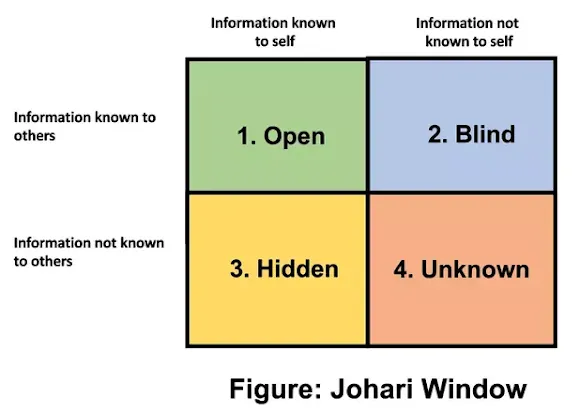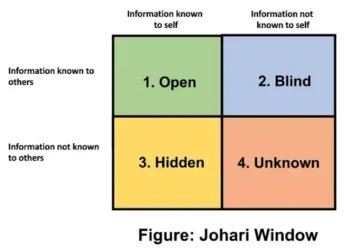Table of Contents:-
- Johari Window Meaning
- Quadrants of Johari Window Model
- Johari Window advantages and disadvantages
- Advantages of Johari Window Model
- Disadvantages of Johari Window
Johari Window Meaning
The Johari Window, which was named after the first names of its inventors, Joseph Luft, and Harry Ingham, is one of the most useful models describing the process of human interaction. Joseph Luft, by employing the “Johari Window” offers a rather unique approach to the study of individual behaviour. He maintains that to understand our behaviour we must examine it “about others”. The Johari window model helps people to understand and improve interpersonal relationship and communication. According to this model, interpersonal effectiveness is directly related to the amount of mutually shared information or congruence. The larger this area becomes, the more effective the communication will be.

Quadrants of Johari Window Model
This model comprises four different quadrants (as shown in the image) that together represent a total person about others based on awareness of behaviour, fasting and motivation. The Johari window quadrants are described below:
Four quadrants of Johari window are given below:
1) Open Self
The open quadrant is quadrant 1 of this model, referring to states about an individual, such as behaviours, feelings, and motives that he knows and is willing to share with others. In a relationship, the individual is sometimes straightforward, open, and sharing. It is clear to both parties what he is doing, how he is feeling, and what his motives are.
2) Blind Self
The blind self is quadrant 2 of this model. It reflects behaviour, feelings and motivation known to other parties but not to self in other words, in this form of interaction, the individual knows about others but not about himself or herself. The individual irritates others unintentionally. Although the latter could tell the former about this aspect, they may be afraid of hurting his or her feelings.
Related Article:- Importance of Organisational Behaviour
3) Hidden Self
The hidden quadrant refers to states about the individual known to him or her but not known to others. This is personal and only the individual concerned knows what is happening. The hidden self is within the vision of the person but he does not want to share it with others. People learn to hide many feelings and ideas right from their childhood.
4) Unknown Self
The unknown quadrant refers to states that neither the individual nor other people know about him. The unknown self is mysterious. Many times, motives and feelings go very deep and no one, including the person concerned, knows about these People often experience these parts of life in dreams or deep-rooted fears or compulsions. These motives act and feelings, remain unclear and vague to people until they allow them to surface.
The process that impacts the shape of the model is the feedback. This is the extent to which others are willing to share with the person how he or she is coming across. It is also the extent to which the person can perceive verbal and non-verbal feedback in the organisational setting. Another important factor that affects the Johan Window is disclosure.
Related Article: Types of Motivation
Johari Window advantages and disadvantages
There are several advantages and disadvantages of Johari Window. Advantages include promoting self-awareness among people and encouraging them to go deep into their emotions, thoughts, and actions, which may ultimately help them in personal growth. If people address aspects about themselves that they didn’t know before, they can experience significant personal development.
Disadvantages include the model having limited scope, not covering all aspects of human behaviour, and some nuances or complexities that may not neatly fit into the four quadrants. Sometimes, possible misinterpretation poses a risk, as people may interpret or perceive information differently. This can lead to problems or conflicts because everyone sees or thinks about things differently.
The advantages and disadvantages of the Johari window are as follows:
Advantages of Johari Window Model
Various advantages of Johari Window are as follows.
1) It can ensure that multiple perspectives are considered when prioritising the findings of the self-need assessment.
2) The results of this exercise can help to communicate with others when prioritising needs and identifying appropriate interventions.
3) Individuals can use this exercise to expand on the findings of the needs assessment to also include information on what preferences differing groups may have on what should be done in response to identified needs.
4) This model can be used as a self-assessment tool to increase individuals’ understanding of themselves. This may be an exploration of the skills they possess or their personal and professional characteristics.
5) As an aid to personal and professional development, this model encourages reflection – enabling individuals and teams to consider strengths and weaknesses not only from their point of view but from their managers’, colleagues’ and customers’ perspectives.
6) As well as being used by individuals, the JW model can be applied by a group to identify team skills and characteristics.
Disadvantages of Johari Window
Various disadvantages of Johari Window are as follows:
1) The technique can be more limited than other tools or techniques (e.g., SWOT or brainstorming) for generating ideas about what to do next.
2) No one should feel obliged to reveal anything about them; they do not feel comfortable sharing. Although individuals may be led to believe that self-disclosure is healthy and can lead to increased trust within a group, inappropriate self-disclosure has its dangers. Individuals are often better off not telling others about their innermost personal secrets (or professional disasters).
3) When encouraging feedback from others, it is important to establish a positive group ethos and to gauge the level of people’s sensitivity. Whereas it can be a great motivator to learn of other people’s positive perceptions of yourself, the discovery of the weaknesses they perceive can have equally negative effects, especially when there is a mismatch between your view and the view of others. That is not to say that weaknesses are not to be explored but this should be done with sensitivity.
You May Also Like:-
Related Questions:
1. What are the 4 quadrants of Johari window.
2. Explain the drawbacks of Johari window.
3. Explain in detail Johari window meaning.
4. Explain the johari window benefits.
5. Explain the pros and cons of johari window.
6. Explain the Johari window theory
7. Explain the Johari window drawbacks
8. Explain the role of Johari window in organisational behaviour
You May Also Like:-
Nature of Organisational Behaviour
Conceptual Foundation of Organisational Behaviour
Contributing Disciplines to organisational behaviour
Models of Organisational Behaviour
Approaches of Organisational Behaviour
Emotional Intelligence in Organisational behaviour
Factors Influencing Perception
Scope of Organisational Behaviour
Importance of Organisational Behaviour
Challenges and Opportunities of Organisational Behaviour
Factors affecting group behaviour
Causes of Conflict in an Organisation
Types of Conflict in an Organisation
Organisational Development Process
Factors Affecting Organisational Culture
Trait Theory: Stogdill’s trait factors
Transactional Analysis in organisational behaviour
